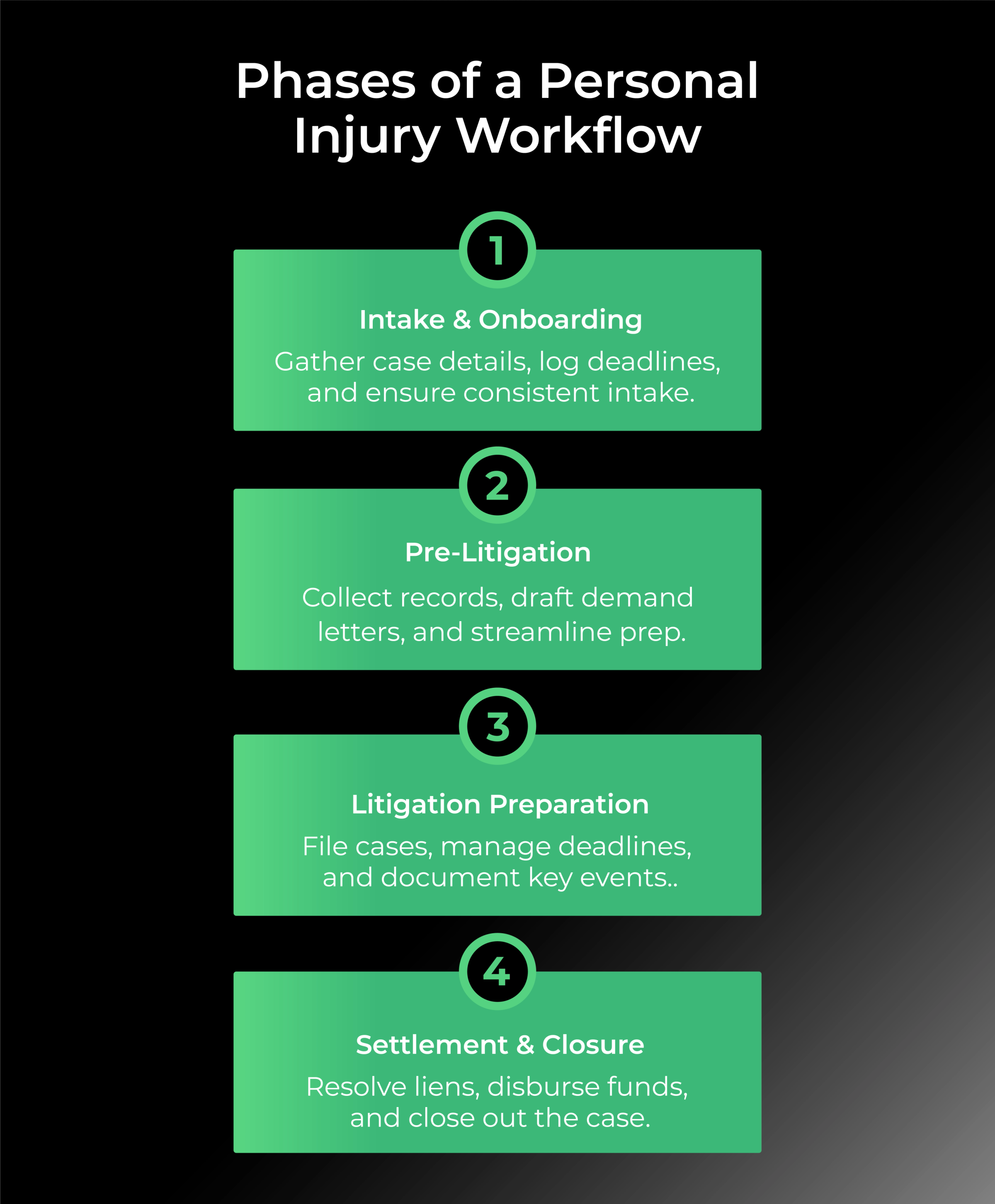Managing a personal injury law firm today demands more than just legal expertise; it requires efficient workflows and organized practice management processes. The pressure to handle increasing caseloads while maintaining high client satisfaction is immense, and without a streamlined process, bottlenecks and missed opportunities can quickly derail even the most promising cases.
This article explores how optimizing your firm’s operations with tech-driven strategies and legal workflow automation can significantly enhance profitability and client outcomes.
How Do I Create a Personal Injury Workflow for My Law Firm?
This article will give you a step-by-step approach to creating an efficient personal injury workflow tailored to your firm’s operations.
While personal injury workflows share common stages—from the initial client consultation and case evaluation to investigation, negotiation, and potentially litigation—the exact progression can vary by jurisdiction or practice area.
The key is to establish a clear framework that guides every action. Think of it as a roadmap for success, minimizing detours and maximizing forward momentum. Adopting workflow software early can provide substantial advantages, helping to organize these complex processes from the outset.
If you're considering starting a personal injury law firm, setting up these foundational workflows is paramount.
What Are the Phases of a Personal Injury Workflow?
A personal injury workflow is a sequence of tasks and responsibilities for managing a case from start to finish. When done well, it prevents delays, reduces errors, and ensures consistent client service. It also aligns your staff, technology, and the natural progression of a case.
Even experienced firms can refine their processes to gain clearer visibility and automate repetitive tasks. Below, we’ll dissect each core phase of the personal injury workflow process, highlighting ways to make each one more efficient and client-centric.

1. Case Intake & Onboarding
Early triage is critical during the case intake and onboarding phase. You’ll want to collect the following details at this stage:
The client's personal details and contact information
Accident specifics (date, location, and circumstances)
Injury descriptions and medical treatment received
Insurance information for all parties involved
Logging the Statute of Limitations (SoL) at this stage also prevents future oversights. Digital templates can help ensure no steps are missed and promote consistency across all new cases.
Finally, while understanding how to get personal injury cases is important, efficiently managing them once they arrive is equally crucial. To support your firm in this first phase, we’ve created a Personal Injury Case Management Checklist—a practical, step-by-step resource that helps ensure no task is missed throughout the process.
2. Pre-Litigation Workflow
The pre-litigation phase lays the groundwork for a personal injury case, from gathering records to issuing demand letters. Streamlining these steps builds a stronger case and improves client outcomes. Furthermore, a well-executed pre-litigation process can save time, reduce costs, and strengthen negotiating power.
A primary focus in this phase is gathering complete and accurate medical records and bills to substantiate the client’s injuries and treatment timeline. Automation, such as utilizing status trackers or e-signature tools, can greatly simplify the often tedious process of requesting medical records and tracking their delivery.
When it comes to drafting demand letters, clearly outlining the damages summary, liability argument, and supporting documentation is key. Using personalized templates can significantly improve both the speed and consistency of this communication.
For more insights, explore these demand letter strategies and examples.
3. Litigation Preparation & Case Filing
When a personal injury case progresses to litigation, preparation and timing become critical. This phase requires PI attorneys to systematize filings, manage deadlines, and maintain detailed documentation to stay organized and increase success rates.
Cases typically escalate to litigation when pre-litigation efforts fall short, such as when liability is denied or settlement offers are unacceptably low. It's essential to understand that escalation is a natural progression for some PI cases, necessitating a clear procedural shift.
Litigation can also introduce unpredictable timelines and court-related delays, making it important to structure workflows to effectively account for long-term resource planning.
Finally, the value of case notes and comprehensive documentation for key events—like depositions, motions, and discovery—cannot be overstated. Case records not only support more favorable outcomes but also ensure team continuity, even if staff changes. Digital solutions, especially those with built-in deadline tracking, like CASEpeer, are invaluable for helping attorneys track court dates, statute-of-limitations filings, and other hard deadlines, preventing critical oversights.
4. Settlement & Case Closure
How do personal injury attorneys perform case status tracking efficiently?
In this final phase, law firms balance case resolution with disbursement, lien resolution, and clear documentation. Case status tracking systems ensure visibility into progress and milestones, helping teams wrap up matters smoothly and get clients paid faster.
Once a settlement is reached, the focus shifts to drafting the agreement, finalizing negotiations, and completing all necessary documentation. Effectively handling payouts and resolving medical liens is also critical at this stage.
Digital checklists and task automation can help greatly. You can also use software with visual case status dashboards and automated reminders to track final tasks and ensure nothing falls through the cracks.
How Do Checklists Compare to Case Management Software?
Many firms still rely on manual systems like personal injury case management spreadsheets or sticky notes to keep track of their workflows. While simple, these tools often lack the automation and oversight required for efficient volume handling. Traditional workflows also often result in fragmented data and missed deadlines because they lack integration, forcing information to be manually transferred between different systems.
A unified platform like CASEpeer offers significant advantages. It eliminates the limitations of manual systems by centralizing information, automating repetitive tasks, and providing a holistic view of every case.
What's Included in a Personal Injury Case Management Checklist?
A detailed case management checklist helps personal injury firms stay on top of intake, case deadlines, and settlement phases. Whether your firm uses spreadsheets or a centralized platform like CASEpeer, a clear checklist is essential for tracking each phase of the process. For a complete breakdown of what to include, explore our Personal Injury Case Management Guide.
Optimizing Payment Processing & Disbursements in PI Law
Modern software solutions offer significant benefits over traditional financial management methods, especially when handling client disbursements, trust accounting, and contingency fee structures. For firms dedicated to superior personal injury law firm management, automation is key.
Tips to Optimize Payment Processing & Disbursements:
Client Disbursements: When a settlement is received, ensure prompt and transparent disbursement of client funds after deductions. Lien tracking tools prevent delays.
Trust Accounting: Use dedicated software to separate operating and client funds to reduce the risk of compliance violations and streamline IOLTA reconciliations.
Fee Structures: Clearly outline contingency fee percentages and standardize them to improve forecasting. Pre-built calculators can help project earnings.
Cash Flow & Forecasting: Build conservative revenue models based on historical win rates and average settlement timelines. Quarterly forecasting reviews help avoid financial bottlenecks.
Automation Opportunities: Automate tasks like trust account reconciliation, lien tracking, and settlement distribution notices. CASEpeer integrates these functions automatically, freeing up time and minimizing errors.
For even more insights on maintaining financial vigilance, refer to our guide: Law Firm Financial Management Tips.
Metrics to Monitor and Optimize Your Personal Injury Workflows
Understanding which performance metrics signal a healthy, streamlined workflow is crucial. Monitor the following key performance indicators (KPIs) to determine where your process excels and where it might need adjustment:
Case Cycle Time: This metric tracks the total time from the initial client intake to the final resolution of the case. A lengthy cycle time can pinpoint delays or slowdowns within your workflow.
Settlement Timelines: Understanding how long it typically takes to reach a settlement is invaluable for projecting future revenue and identifying potential bottlenecks in negotiation strategies.
Touchpoints per Case Phase: Analyzing the number of interactions or steps involved in each case phase can reveal inefficiencies (if there are too many) or indicate missed opportunities for communication or action (if there are too few).
Referral Rates: A strong indicator of client satisfaction and overall firm health. High referral rates often correlate with efficient, client-centered workflows.
Workflow Bottlenecks: Actively evaluating where cases commonly experience delays—such as during intake, medical record requests, or approval processes—is crucial for process optimization.
Regularly auditing these metrics—on a monthly or quarterly basis—empowers your firm to refine its processes continuously and boost operational efficiency. This approach aligns with law firm workflow best practices recommended by the American Bar Association.
Other Ways to Automate Legal Workflows
Legal workflow automation reduces manual task load and improves consistency across PI case phases. It involves using legal technology to automate repetitive tasks across intake, document collection, communication, billing, and resolution.
Common automation opportunities to improve legal workflow efficiency include:
Appointment Reminders: Automated text or email reminders can significantly reduce no-shows and streamline client coordination.
Document Intake: Implementing e-signature solutions and secure document request systems eliminates the need for manual follow-ups.
Billing Triggers: Automated triggers can notify finance staff to prepare disbursements or track liens when a case transitions from discovery to settlement negotiation.
Settlement Logged: When a settlement is recorded, workflows can be triggered to ensure funds are properly moved from trust accounts, fees are accurately calculated, and clients are promptly paid.
Document or Medical Bill Upload: An automated prompt can alert your team to reassess the projected settlement value based on new evidence as soon as it's uploaded.
Ultimately, automation leads to reduced overhead, faster case movement, and lower administrative errors. As highlighted by MyCase, there are numerous benefits of legal automation.
For a deeper dive, see our blog: How to Automate Your Law Firm in 2025.
CASEpeer Helps Automate Personal Injury Workflows
Streamlined workflows help personal injury firms save time, improve profitability, and enhance client service. Even established firms can benefit from refining intake, communication, and resolution phases. Improve your personal injury firm workflows with CASEpeer—built specifically for PI firms looking to optimize case management.
Ready to streamline your practice? Book a demo with CASEpeer today to see how we can help.
Personal Injury Workflow FAQs
About the author

Gabriela Jhean
Gabriela Jhean is a Content Writer for leading legal software companies, including MyCase, Docketwise, and CASEpeer, as well as LawPay, the #1 legal payment processor. She covers emerging legal technology, financial wellness for law firms, the latest industry trends, and more.
